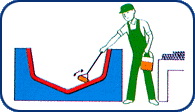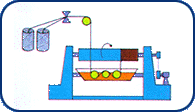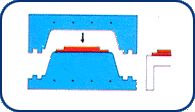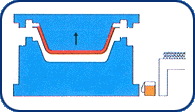| 1. Hand Lay Up |
| After spreading wax on mold, the surface mat
of thickness 0.3∼0.5㎜ is laminated with roller until you get thickness and
strength you need. It's common formation method applied to complex or small
to large forms. It's possible to change strength or thickness partly in
laminating. |
 |
2. Spray Up
|

|
After spreading wax on mold, spray
the compound of resin and fiberglass through a spray gun on the mold until
it gets thickness. |
3. Filament Winding |
| Wind roving absorbed in resin on
rotating mandrel and then cure. |
 |
4. Lining |
| Clean surface for lining, and then spread primer.
Spread resin added filler or laminate glass and resin. |
5. S.M.C(Sheet Molding Compound)
|
Heat and press to form on a mold and a press.
Cut glass mat as the form and put on the mold. Insert resin and then press.
The SMC method is applied to most large formation such as panel tanks, tubs
or unit baths, purification tanks, parts of cars, cooling towers, and parabola
antennas. |
 |
6. B.M.C(Bulk Molding Compound)
|
 |
Heat and press dough with resin filler, glass
fiber, catalyst etc.
The BMC method is used to small and complex products, parts of cars like
head reflector and air intake, parts for copy machine or printers, and housing. |
7. Cold Press
|
| It is a method to form at normal temperature
or up to 60℃ in a couple of molds. The molds are fixed at a press. Provide
glass fiber and resin(usually use unsaturated polyester) together into opened
molds by the press. Close and lock molds and form under pressure until cure
available to unmold. |
 |
 |
 |
 |








